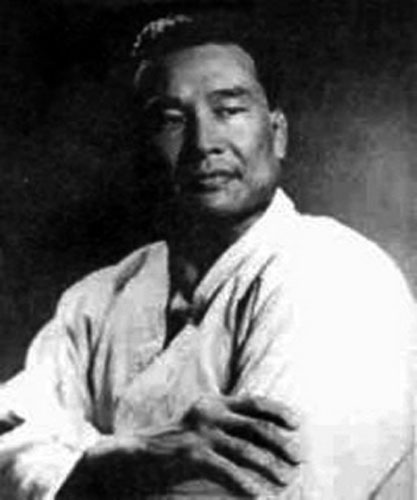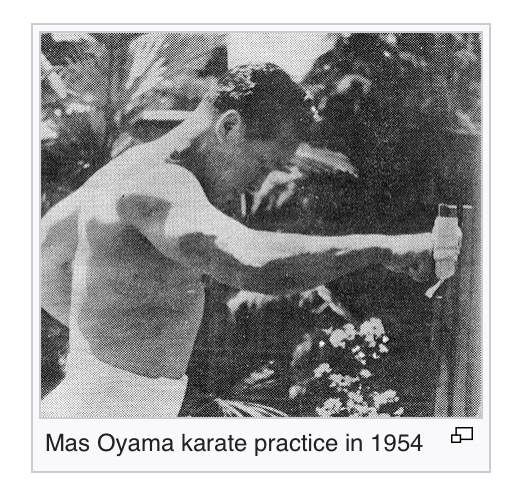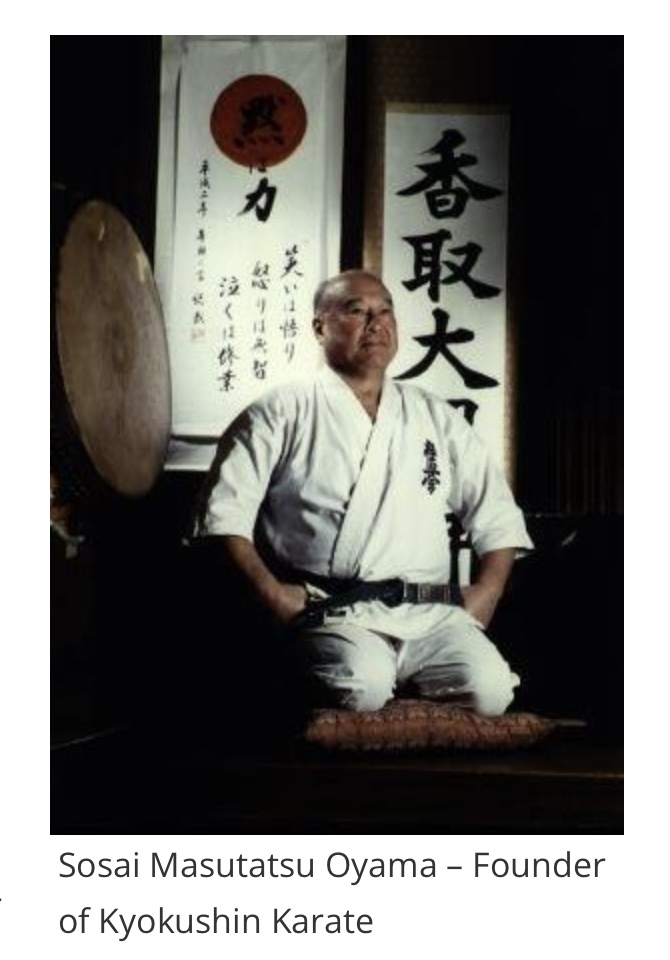History of Kyokushin-Ryu

Welcome to the History of Kyokushin-Ryu from the World Budo Alliance.
Mas Oyama - founder of Kyokushin Karate-Do (June 4th 1923 - April 26th 1994)
Mas Oyama was born on July 27, 1923 in Korea, near Seoul. Within 9 years, since the studies in elementary school, he began to study Chinese Kempo and in 1936 received a black belt. And in 1938, he moved to Japan, where he enrolled in the Institute of Aviation. At this time, he masters judo. And at this time became a pupil of Gichin Funakoshi. Who was one of the three masters of Okinawa, which brought karate to Japan. In 1940 he received the 2nd Dan and enters the Takushoku University.
In 1946, Oyama went to the Faculty of Physical Education Waseda University. An in a complex and controversial situation of post-war Japan, he did not immediately find his place. But is keenly aware of "cultural-environmental" crisis of the tradition of the Far Eastern martial arts. By the middle of the 20th century, after the most famous judo karate styles, degenerating into shareware game types "contact less" sports, gain mass popularity.
Specificity of karate as a martial art is being lost. And at the same time under the influence of the ideology of Western sports is tested for strength and spiritual and moral basis of the centuries-old tradition of arts Budo. Oyama seeks to find a source for the revival of traditional karate. Refers to the study of the old way of the samurai, Miyamoto Musashi to biographies, famous master of Kendo. Plus visited the two famous writers Eiji Yoshikawa and Shiro Ozaki. Who are connoisseurs of Japanese history. As well as making the first practical step in finding their way, going to exercise in the privacy of the mountain Minobu.
History of Kyokushin-Ryu
Oyama efforts aimed at reviving Budo karate. Karate that is understood not as a sport but as a real martial art, very soon bear fruit. In 1947 he participated in the first All-Japan championship in Kyoto. And he wins a convincing victory over all rivals. Even though he must control the degree of contact in the fighting according to the rules of the sports. In the same year he became the owner of 4th Dan Black Belt. It was then Oyama decides to devote his life to karate. In 1948, following the precepts of the old masters, it goes back into the mountains alone to focus on improving technology and strengthening of body and spirit.
On the mountain Kiёdzuma in Chiba Prefecture, as well as its famous predecessors, Oyama passed 18-month exclusively heavy course discipline. He lives an intense spiritual life, studying the works of ancient sages and following the recommendations of the Zen masters in search of enlightenment.
And according to him, at this time "training more than sleep." Thus exposing themselves to severe physical tests required of the adept of martial arts. Plus laid the foundation for a new style of karate and school, dates back to the reality of the Arts of Budo. And thus transformed into a special way of improving human rights. Oyama set out to develop maximum strength, endurance and "killing power" of the body. Done in order to subsequently establish themselves in Japan to counter the style of "limited" sports karate martial arts now. During the brief but fruitful asceticism in the mountains Oyama lived strictly to develop a regime that often appears in the biography of the master and the doctrine is frivolous disciples.
Founding Kyokushin-Ryu

In 1953 Oyama opened his own karate dojo. Which he named Oyama Dojo (form of Gōjū-ryū), And was located in Tokyo but continued to travel around Japan and the world giving martial arts demonstrations. This included knocking live bulls unconscious with his bare hands.
His dojo was first located outside in an empty lot but eventually moved into a ballet school in 1956. The senior instructors under him were T. Nakamura, K. Mizushima, E. Yasuda, M. Ishibashi, and T. Minamimoto. Oyama's own curriculum soon developed a reputation as a tough, intense, hard-hitting but practical style.
Which was finally named Kyokushinkai (Japan Karate-Do Kyokushinkai), which means 'the ultimate truth,' in a ceremony in 1957.
He also developed a reputation for being 'rough' with his students. Most of all the training sessions were grueling and students injuring themselves in practice fighting (kumite) was quite common. Along with practice fighting that distinguished Oyama's teaching style from other karate schools, emphasis on breaking objects such as boards, tiles, or bricks. This was to measure one's offensive ability became Kyokushin's trademark.
History of Kyokushin-Ryu
Oyama believed in the practical application of karate and declared that ignoring 'breaking practice is no more useful than a fruit tree that bears no fruit.' As the reputation of the Dojo grew students were attracted to come to train there from inside and outside Japan. Therefore the number of students grew. Many of the eventual senior leaders of today's various Kyokushin based organisations began training in the style during this time.
In 1954 he opened the first Dojo in Tokyo Oyama, where instructors began K. Mizushima and E. Yasuda. Plus he continues to travel to different countries and continents. And is involved in numerous fights, demonstrating their outstanding achievements.
In 1956 he opened another Dojo Ryadoms Rikkyo University. By the same instructors joined M. Ishibashi and T. Minamimoto. It was the beginning of Karate Dojo, based on the principle of "1,000 days of training for the beginner, 10,000 days - a glimpse of the mystery." This is indicative of the highest standards of style - Kiokusin Budo karate. The new style has quickly gained the sympathy of many fans of martial arts.
An in 1961 at the All-Japan Student Open Karate Championship, one of Oyama's students, Tadashi Nakamura, at 19 years old (1961) made his first tournament appearance, where he was placed first. Nakamura later became Mas Oyama's Chief Instructor as referenced in Mas Oyama's book, "This is Karate."
History of Kyokushin-Ryu
In 1964 Oyama moved the Dojo into the building that would from then on serve as the Kyokushin home Dojo and world headquarters. And in connection with this he also formally founded the 'International Karate Organization Kyokushin kaikan' to organize the many schools that were by then teaching the Kyokushin style.
Also in 1969, Oyama staged the first All-Japan Full Contact Karate Open Championships which took Japan by storm and Terutomo Yamazaki became the first champion, which have been held every year since. In 1975, the first World Full Contact Karate Open Championships were held in Tokyo.

Oyama and his staff of hand-picked instructors displayed great ability in marketing the style and gaining new members.
Also Oyama would choose an instructor to open a Dojo in another town or city in Japan. And whereupon the instructor would move to that town.
And, typically demonstrate his karate skills in public places, such as at the civic gymnasium, the local police gym, a local park. Or conduct martial arts demonstrations at local festivals or school events.
The History of Kyokushin-Ryu is very rich. And it is also to this date a very popular martial art around the world.
Researched by Sensei Kara Borshuk
Edited by Grand Master Art Mason